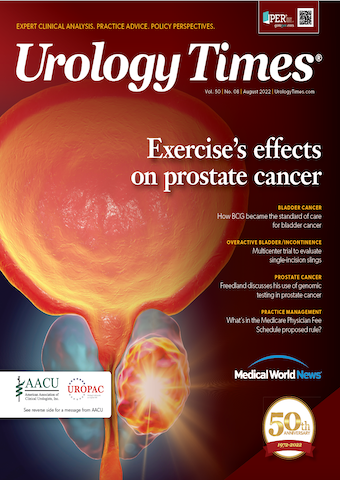Publication
Article
Urology Times Journal
The effects of exercise before and after a prostate cancer diagnosis
Author(s):
"This article serves as a summary of the literature published in the past 3 years, documenting the impact of exercise and physical activity on prostate cancer development and on cancer-specific, treatment-related, and patient-reported outcomes," writes Christine Ibilibor, MD, MSc.
Christine Ibilibor, MD, MSc

Ibilibor is an assistant professor of urology at the University of Virginia in Charlottesville.
Prostate cancer remains a common malignancy among men, particularly those in good health. The effects of global health status and physical activity on prostate cancer prevention and survival after diagnosis are gaining increased attention as the prevalence of obesity and sedentariness increase in our population. Men with risk factors for prostate cancer development and men newly diagnosed with prostate cancer are increasingly interested in how natural and noninvasive strategies such as exercise can contribute to prostate cancer prevention and survivorship.
This article serves as a summary of the literature published in the past 3 years, documenting the impact of exercise and physical activity on prostate cancer development and on cancer-specific, treatment-related, and patient-reported outcomes. Additional studies outside this time frame were reviewed to provide further context.
Physical activity and prevention
The link between exercise and prostate cancer development has been investigated extensively; however, a direct correlation has not been made, given the multifactorial and complex nature of prostate cancer carcinogenesis.1-3
For example, a study by Reiter-Brennan et al noted no significant association between cardiorespiratory fitness and the risk of developing advanced prostate cancer. Within their large cohort of 22,827 men with no prior prostate cancer diagnosis undergoing prostate cancer screening, those with higher fitness defined as at least 12 metabolic equivalents (METs) calculated on a single exercise test session were 29% more likely to be screened for prostate cancer and ultimately diagnosed vs men with fewer than 6 METs on baseline exercise testing. The study authors noted that the higher incidence of prostate cancer diagnosis observed among the group of men with a higher activity level may only be partially attributed to the higher rate of screening.4
Conversely, a systematic review reported that although increased physical activity likely has a protective effect on prostate cancer development, there is a large amount of heterogeneity in the studies investigating the impact of both leisure and occupational exercise on prostate cancer incidence.1
There are a number of proposed mechanisms for the potentially beneficial effects of exercise on prostate cancer carcinogenesis, including reduction in oxidative stress, improvement in the expression of anti-inflammatory markers, and activation of proapoptotic pathways.2 For example, a small, randomized, controlled trial conducted by Schenk et al demonstrated that a single 30-minute session of aerobic exercise was associated with increased expression of the kynurenine pathway, a pathway known to enhance the expression of anti-inflammatory markers such as transforming growth factor β.5 Although many studies have documented the complex interaction between the differing mechanisms by which both occupational and recreational exercise can contribute to reducing the risk of prostate cancer development, none have reported a single mechanism that is predominant compared with the others.2
Exercise and mortality
Regular exercise has been associated with overall global health and longevity.6,7 One study reported a dose-dependent association between patient-reported activity level and number of years lived with good health. Participants in that study aged 50 to 75 years who reported at least 60 MET hours per week of physical activity were demonstrated to live 6.3 years longer in good health compared with those in this age group who reported fewer than 7 MET hours per week.7 Within this context, the effect of regular exercise on all-cause and cancer-specific mortality in prostate cancer has been reported to be favorable.8,9
One study including 830 men with stage II to IV prostate cancer demonstrated that men who reported more than 119 MET hours per week per year experienced a 42% reduction in the risk of death from any cause compared with men who reported less than or equal to 42 MET hours per week per year.10 This is equivalent to approximately 137 minutes per week of moderate exercise over a year period. This is only slightly below the US Department of Health and Human Services (HHS) physical activity recommendations of 150 minutes per week of moderate exercise, highlighting the clinical relevance of this recommendation in prostate cancer survivorship.11
Interestingly, a recent study demonstrated that the positive effects of vigorous exercise on prostate cancer progression and cancer-specific mortality are mediated through alterations in DNA methylation profiles. In a study by Dai et al, men with prostate cancer who reported vigorous exercise for at least 20 minutes weekly the year prior to diagnosis experienced a 43% reduction in the risk of lethal metastatic progression compared with men who reported less-frequent vigorous activity prior to diagnosis. Moreover, men with a history of weekly vigorous exercise were found to have lower levels of methylation in the CRACR2A gene, which encodes a calcium-binding protein thought to be involved in prostate cancer progression.12
Exercise and prostate cancer treatment
Patients with prostate cancer receiving androgen deprivation therapy (ADT) often experience loss in lean muscle and bone mass as well as an increase in fat mass.13 Physical exercise has been reported to offset the effects of ADT on lean muscle by promoting and preserving physical functioning. In addition, aerobic exercise while on ADT has been shown to enhance patient-
reported quality of life.14 A study by Reale et al showed that implementing a 12-week aerobic and resistance training program involving twice-weekly supervised exercise sessions for men on ADT is feasible with high adherence and improved patient-reported quality of life.15 Similarly, a secondary analysis of 2 randomized controlled trials by Schumacher et al showed that men receiving radiation and ADT who engaged in supervised aerobic exercise and resistance training 2 to 3 times weekly scored higher on physical functioning measures such as leg and arm 1-repetition maximums.16
Physical exercise has also been associated with improved patient-reported functional and prostate cancer–specific well-being in men undergoing radical prostatectomy.17 Ashton et al demonstrated that a 6-month resistance-exercise training program consisting of 3-times-weekly sessions was associated with patient-reported Functional Assessment of Cancer Therapy—Prostate, or FACT-P, questionnaire scores that were 5 points higher in the exercise group compared with usual care at 3 months and
4.2 points higher at 6 months.17 Similarly, men receiving radiation therapy have been shown to benefit from physical exercise.16,18 Physical exercise has been documented in preclinical studies to enhance the therapeutic effect of radiation by promoting perfusion and reducing hypoxia in the tumor microenvironment.18 Moreover, a randomized controlled trial by Piraux et al reported attenuated treatment-related fatigue in men undergoing radiotherapy for prostate cancer and participating in high-intensity interval training 3 times weekly compared with usual care.19
Although prostate cancer management primarily involves the use of pharmaceutical agents, radiation modalities, and invasive surgery, physical exercise can serve as an important physical function–preserving, treatment-enhancing adjunct. Although the effect of exercise on prostate cancer development is unclear, the biochemical and physiologic benefits of physical exercise after prostate cancer diagnosis can contribute to long-term patient survival, treatment-related outcomes, and quality-of-life metrics. Currently, there are no standardized recommendations for physical activity in national prostate cancer guidelines; however, those put forth by the HHS can serve as an important guideline for clinical practice given their prior clinical utility.
References
1. Brookman-May SD, Campi R, Henríquez JDS, et al. Latest evidence on the impact of smoking, sports, and sexual activity as modifiable lifestyle risk factors for prostate cancer incidence, recurrence, and progression: a systematic review of the literature by the European Association of Urology Section of Oncological Urology (ESOU). Eur Urol Focus. 2019;5(5):756-787. doi:10.1016/j.euf.2018.02.007
2. Capece M, Creta M, Calogero A, et al. Does physical activity regulate prostate carcinogenesis and prostate cancer outcomes? a narrative review. Int J Environ Res Public Health. 2020;17(4):1441. doi:10.3390/ijerph17041441
3. Rocha-Rodrigues S, Matos A, Afonso J, et al. Skeletal muscle-adipose tissue-tumor axis: molecular mechanisms linking exercise training in prostate cancer. Int J Mol Sci. 2021;22(9):4469. doi:10.3390/ijms22094469
4. Reiter-Brennan C, Dzaye O, Al-Mallah MH, et al. Fitness and prostate cancer screening, incidence, and mortality: results from the Henry Ford Exercise Testing (FIT) Project. Cancer. 2021;127(11):1864-1870. doi:10.1002/cncr.33426
5. Schenk A, Esser T, Knoop A, et al. Effect of a single bout of aerobic exercise on kynurenine pathway metabolites and inflammatory markers in prostate cancer patients-a pilot randomized controlled trial. Metabolites. 2020;11(1):4. doi:10.3390/metabo11010004
6. Saint-Maurice PF, Graubard BI, Troiano RP, et al. Estimated number of deaths prevented through increased physical activity among US adults. JAMA Intern Med. 2022;182(3):349-352. doi:10.1001/jamainternmed.2021.7755
7. Leskinen T, Stenholm S, Aalto V, Head J, Kivimäki M, Vahtera J. Physical activity level as a predictor of healthy and chronic disease-free life expectancy between ages 50 and 75. Age Ageing. 2018;47(3):423-429. doi:10.1093/ageing/afy016
8. Bonn SE, Sjölander A, Lagerros YT, et al. Physical activity and survival among men diagnosed with prostate cancer. Cancer Epidemiol Biomarkers Prev. 2015;24(1):57-64. doi:10.1158/1055-9965.EPI-14-0707
9. Langlais CS, Graff RE, Van Blarigan EL, et al. Post-diagnostic dietary and lifestyle factors and prostate cancer recurrence, progression, and mortality. Curr Oncol Rep. 2021;23(3):37. doi:10.1007/s11912-021-01017-x
10. Friedenreich CM, Wang Q, Neilson HK, Kopciuk KA, McGregor SE, Courneya KS. Physical activity and survival after prostate cancer. Eur Urol. 2016;70(4):576-585. doi:10.1016/j.eururo.2015.12.032
11. Piercy KL, Troiano RP. Physical activity guidelines for Americans from the US Department of Health and Human Services. Circ Cardiovasc Qual Outcomes. 2018;11(11):e005263. doi:10.1161/CIRCOUTCOMES.118.005263
12. Dai JY, Wang B, Wang X, et al. Vigorous physical activity is associated with lower risk of metastatic-lethal progression in prostate cancer and hypomethylation in the CRACR2A gene. Cancer Epidemiol Biomarkers Prev. 2019;28(2):258-264. doi:10.1158/1055-9965.EPI-18-0622
13. Wilson RL, Taaffe DR, Newton RU, Hart NH, Lyons-Wall P, Galvão DA. Using exercise and nutrition to alter fat and lean mass in men with prostate cancer receiving androgen deprivation therapy: a narrative review. Nutrients. 2021;13(5):1664. doi:10.3390/nu13051664
14. Bourke L, Gilbert S, Hooper R, et al. Lifestyle changes for improving disease-specific quality of life in sedentary men on long-term androgen-deprivation therapy for advanced prostate cancer: a randomised controlled trial. Eur Urol. 2014;65(5):865-872. doi:10.1016/j.eururo.2013.09.040
15. Reale S, Turner RR, Sutton E, et al. Embedding supervised exercise training for men on androgen deprivation therapy into standard prostate cancer care: a feasibility and acceptability study (the STAMINA trial). Sci Rep. 2021;11(1):12470. doi:10.1038/s41598-021-91876-y
16. Schumacher O, Galvão DA, Taaffe DR, et al. Effect of exercise adjunct to radiation and androgen deprivation therapy on patient-reported treatment toxicity in men with prostate cancer: a secondary analysis of 2 randomized controlled trials. Pract Radiat Oncol. 2021;11(3):215-225. doi:10.1016/j.prro.2021.01.005
17. Ashton RE, Aning JJ, Tew GA, Robson WA, Saxton JM. Supported progressive resistance exercise training to counter the adverse side effects of robot-assisted radical prostatectomy: a randomised controlled trial. Support Care Cancer. 2021;29(8):4595-4605. doi:10.1007/s00520-021-06002-5
18. Schumacher O, Galvão DA, Taaffe DR, Chee R, Spry N, Newton RU. Exercise modulation of tumour perfusion and hypoxia to improve radiotherapy response in prostate cancer. Prostate Cancer Prostatic Dis. 2021;24(1):1-14. doi:10.1038/s41391-020-0245-z
19. Piraux E, Caty G, Renard L, et al. Effects of high-intensity interval training compared with resistance training in prostate cancer patients undergoing radiotherapy: a randomized controlled trial. Prostate Cancer Prostatic Dis. 2021;24(1):156-165. doi:10.1038/s41391-020-0259-6




























